Ocean Thermal Energy Conversion—Flexible Enabling Technology for Variable Renewable Energy Integration in the Caribbean
Abstract
1. Introduction
1.1. Status of Renewables across the Caribbean
1.2. Summary of Dispatchable Renewable Technologies and OTEC Potential
1.3. OTEC, SWAC and Desalination
2. Materials and Methods
2.1. GIS Bathymetry Mapping of the Caribbean Region
2.2. Summary of Economic Parameters for OTEC and Desalination
2.3. Load, Residual Load and System Benefits of Dispatchable Renewable Energy
3. Results
3.1. GIS Mapping of Deep Water at Different Distances from the Coast
3.1.1. Greater Antilles (with The Bahamas and Turks and Caicos)
3.1.2. Lesser Antilles
3.1.3. Summary of Promising OTEC Sites
3.2. Results for Balancing Dispatchable OTEC Technology with Variable Renewables and Battery Storage
3.3. Results for System Levelized Cost of Energy
4. Discussion
5. Conclusions
Supplementary Materials
Author Contributions
Funding
Institutional Review Board Statement
Informed Consent Statement
Data Availability Statement
Conflicts of Interest
References
- Thomas, A.; Schleussner, C.-F.; Kumar, M. Small island developing states and 1.5 °C. Reg. Environ. Chang. 2018, 18, 2197–2200. [Google Scholar] [CrossRef]
- IPCC Intergovernmental Panel on Climate Change. Global Warming of 1.5 °C. An IPCC Special Report on the Impacts of Global Warming of 1.5 °C above Pre-Industrial Levels and Related Global Greenhouse Gas Emission Pathways; World Meteorological Organization: Geneva, Switzerland, 2018. [Google Scholar]
- Lewis, A.; Estefen, S.F.; Huckerby, J.; Lee, K.S.; Musial, W.D.; Pontes, T.; Torres-Martinez, J.; Bharathan, D.; Hanson, H.P.; Heath, G.; et al. Ocean Energy. In Renewable Energy Sources and Climate Change Mitigation; Cambridge University Press (CUP): Cambridge, UK, 2011; pp. 497–534. [Google Scholar]
- IRENA (International Renewable Energy Agency). Ocean Energy—Technology Readiness, Patent, Deployment Status and Outlook; International Renewable Energy Agency: Abu Dhabi, United Arab Emirates, 2014. [Google Scholar]
- Watt, A.; Mathews, F.; Hathaway, R. Open Cycle Ocean Thermal Energy Conversion: A Preliminary Engineering Evaluation. Final Report; Department of Energy: Denver, CO, USA, 1977.
- Vega, L.A. Economics of Ocean Thermal Energy Conversion (OTEC). In Ocean Energy Recovery: The State of the Art; American Society of Civil Engineers: New York, NY, USA, 1992; pp. 152–181. [Google Scholar]
- Lennard, D. The viability and best locations for ocean thermal energy conversion systems around the world. Renew. Energy 1995, 6, 359–365. [Google Scholar] [CrossRef]
- Vega, L.A. Economies of ocean thermal energy conversion (OTEC): An update. In Proceedings of the Annual Offshore Technology Conference, Houston, TX, USA, 3–6 May 2010; pp. 3239–3256. [Google Scholar]
- Suberu, M.Y.; Mustafa, M.W.; Bashir, N. Energy storage systems for renewable energy power sector integration and mitigation of intermittency. Renew. Sustain. Energy Rev. 2014, 35, 499–514. [Google Scholar] [CrossRef]
- Fujita, R.; Markham, A.C.; Diaz, J.E.D.; Garcia, J.R.M.; Scarborough, C.; Greenfield, P.; Black, P.; Aguilera, S.E. Revisiting ocean thermal energy conversion. Mar. Policy 2012, 36, 463–465. [Google Scholar] [CrossRef]
- Arrow, K.J. The Economic Implications of Learning by Doing. Rev. Econ. Stud. 1962, 29, 155–173. [Google Scholar] [CrossRef]
- Grübler, A.; Nakićenović, N.; Victor, D.G. Dynamics of energy technologies and global change. Energy Policy 1999, 27, 247–280. [Google Scholar] [CrossRef]
- Nemet, G.F. Beyond the learning curve: Factors influencing cost reductions in photovoltaics. Energy Policy 2006, 34, 3218–3232. [Google Scholar] [CrossRef]
- Creutzig, F.; Agoston, P.; Goldschmidt, J.C.; Luderer, G.; Nemet, G.; Pietzcker, R.C. The underestimated potential of solar energy to mitigate climate change. Nat. Energy 2017, 2, 17140. [Google Scholar] [CrossRef]
- Nihous, G.C. A Preliminary Assessment of Ocean Thermal Energy Conversion Resources. J. Energy Resour. Technol. 2006, 129, 10–17. [Google Scholar] [CrossRef]
- Lazard. Lazard’s Levelized Cost of Storage 4.0; Lazard: New York, NY, USA, 2018. [Google Scholar]
- International Renewable Energy Agency (IRENA). Electricity Storage and Renewables: Costs and Markets to 2030; International Renewable Energy Agency: Abu Dhabi, United Arab Emirates, 2017; Available online: https://www.irena.org/publications/2017/Oct/Electricity-storage-and-renewables-costs-and-markets (accessed on 13 April 2021).
- Martin, B.; Okamura, S.; Town, K. Status of the ’Kumejima Model’ for Advanced Deep Seawater Utilization. 2016 Techno Ocean 2016, 211–216. [Google Scholar] [CrossRef]
- Ochs, A.; Konold, M.; Auth, K.; Musolino, E.; Killeen, P. Caribbean Sustainable Energy Roadmap and Strategy; Worldwatch Institute: Washington, DC, USA, 2015. [Google Scholar]
- Koon Koon, R.; Marshall, S.; Morna, D.; McCallum, R.; Ashtine, M. A Review of Caribbean Geothermal Energy Resource Potential. West Indian J. Eng. 2020, 42, 37–43. [Google Scholar]
- Chen, A.; Stephens, A.; Koon, R.K.; Ashtine, M.; Koon, K.M.-K. Pathways to climate change mitigation and stable energy by 100% renewable for a small island: Jamaica as an example. Renew. Sustain. Energy Rev. 2020, 121, 109671. [Google Scholar] [CrossRef]
- Bellini, E. Hydrogen Based Solar-Plus-Storage Project Launched in French Guiana. PV Magazine. 29 May 2018. Available online: https://www.pv-magazine.com/2018/05/29/hydrogen-based-solar-plus-storage-project-launched-in-french-guiana/ (accessed on 13 April 2021).
- National Renewable Energy Laboratory (NREL). Island Energy Snapshots; National Renewable Energy Laboratory: Denver, CO, USA, 2021. Available online: https://www.energy.gov/eere/island-energy-snapshots (accessed on 13 April 2021).
- Espinoza, P.; Arce, E.; Daza, D.; Faure, M.; Terraza, H. Regional Evaluation on Urban Solid Waste Management in Latin America and the Caribbean; Inter-American Development Bank IDB-MG-115. 2010. Available online: https://publications.iadb.org/publications/english/document/Regional-Evaluation-on-Urban-Solid-Waste-Management-in-Latin-America-and-the-Caribbean-2010--Report.pdf (accessed on 13 April 2021).
- Arena, U.; Ardolino, F.; Di Gregorio, F. A life cycle assessment of environmental performances of two combustion-and gasification-based waste-to-energy technologies. Waste Manag. 2015, 41, 60–74. [Google Scholar] [CrossRef] [PubMed]
- ND-GAIN. Notre Dame Global Adaptation Index. 2021. Available online: https://gain.nd.edu/ (accessed on 13 April 2021).
- Nihous, G.C. Mapping available Ocean Thermal Energy Conversion resources around the main Hawaiian Islands with state-of-the-art tools. J. Renew. Sustain. Energy 2010, 2, 43104. [Google Scholar] [CrossRef]
- Makai Ocean Engineering. A Pre-Feasibility Study for Deep Seawater Air Conditioning Systems in the Caribbean; CAF—Latin America Development Bank: Caracas, Venezuela, 2015; Available online: http://scioteca.caf.com/handle/123456789/806 (accessed on 13 April 2021).
- Bernardoni, C.; Binotti, M.; Giostri, A. Techno-economic analysis of closed OTEC cycles for power generation. Renew. Energy 2019, 132, 1018–1033. [Google Scholar] [CrossRef]
- Wang, M.; Jing, R.; Zhang, H.; Meng, C.; Li, N.; Zhao, Y. An innovative Organic Rankine Cycle (ORC) based Ocean Thermal Energy Conversion (OTEC) system with performance simulation and multi-objective optimization. Appl. Therm. Eng. 2018, 145, 743–754. [Google Scholar] [CrossRef]
- Straatman, P.J.T.; Van Sark, W.G.J.H.M. A New Hybrid Ocean Thermal Energy Conversion-Offshore Solar Pond (OTEC-OSP) Design: A Cost Optimization Approach. Renew. Energy 2018, 82, 501–513. [Google Scholar]
- Park, S.; Chun, W.; Kim, N. Simulated production of electric power and desalination using Solar-OTEC hybrid system. Int. J. Energy Res. 2016, 41, 637–649. [Google Scholar] [CrossRef]
- Kim, A.S.; Kim, H.-J.; Lee, H.-S.; Cha, S. Dual-use open cycle ocean thermal energy conversion (OC-OTEC) using multiple condensers for adjustable power generation and seawater desalination. Renew. Energy 2016, 85, 344–358. [Google Scholar] [CrossRef]
- Chen, F.; Liu, L.; Peng, J.; Ge, Y.; Wu, H.; Liu, W. Theoretical and experimental research on the thermal performance of ocean thermal energy conversion system using the rankine cycle mode. Energy 2019, 183, 497–503. [Google Scholar] [CrossRef]
- Ikegami, Y.; Yasunaga, T.; Morisaki, T. Ocean Thermal Energy Conversion Using Double-Stage Rankine Cycle. J. Mar. Sci. Eng. 2018, 6, 21. [Google Scholar] [CrossRef]
- Mutair, S.; Ikegami, Y. Design Optimization of Shore-Based Low Temperature Thermal Desalination System Utilizing the Ocean Thermal Energy. J. Sol. Energy Eng. 2014, 136, 041005. [Google Scholar] [CrossRef]
- Yeh, R.-H.; Su, T.-Z.; Yang, M.-S. Maximum output of an OTEC power plant. Ocean Eng. 2005, 32, 685–700. [Google Scholar] [CrossRef]
- Aydin, H.; Lee, H.-S.; Kim, H.-J.; Shin, S.K.; Park, K. Off-design performance analysis of a closed-cycle ocean thermal energy conversion system with solar thermal preheating and superheating. Renew. Energy 2014, 72, 154–163. [Google Scholar] [CrossRef]
- Idrus, N.M.; Musa, M.; Yahya, W.; Ithnin, A. Geo-Ocean Thermal Energy Conversion (GeOTEC) power cycle/plant. Renew. Energy 2017, 111, 372–380. [Google Scholar] [CrossRef]
- Hunt, J.D.; Byers, E.; Sánchez, A.S. Technical potential and cost estimates for seawater air conditioning. Energy 2019, 166, 979–988. [Google Scholar] [CrossRef]
- Devis-Morales, A.; Montoya-Sánchez, R.A.; Osorio, A.F.; Otero-Díaz, L.J. Ocean thermal energy resources in Colombia. Renew. Energy 2014, 66, 759–769. [Google Scholar] [CrossRef]
- Puerto Rico Department of Economic Development and Commerce (DEDC). Puerto Rico Ocean Technology Complex (PROTECH) Proposed Roadmap for Development. 2020. Available online: https://www.ddec.pr.gov/en/protech-rfp/ (accessed on 13 April 2021).
- International Hydrographic Organization; UNESCO; Intergovernmental Oceanographic Commission. General Bathymetric Chart of the Oceans. 2021. Available online: https://www.gebco.net/ (accessed on 18 February 2021).
- Seungtaek, L.; Hosaeng, L.; Junghyun, M.; Hyeonju, K. Simulation data of regional economic analysis of OTEC for applicable area. Processes 2020, 8, 1107. [Google Scholar] [CrossRef]
- Ram, M.; Bogdanov, D.; Aghahosseini, A.; Gulagi, A.; Oyewo, S.A.; Child, M.; Caldera, U.; Farfan, J.; Barbosa, L.S.N.S.; Fasihi, M.; et al. Global Energy System Based on 100% Renewable Energy—Power, Heat, Transport and Desalination Sectors Study by Lap-peenranta University of Technology and Energy Watch Group; Lappeenranta, Berlin. March 2019. Available online: http://energywatchgroup.org/new-study-global-energy-system-based-100-renewable-energy (accessed on 13 April 2021).
- Löffler, K.; Hainsch, K.; Burandt, T.; Oei, P.-Y.; Kemfert, C.; von Hirschhausen, C. Designing a Model for the Global Energy System—GENeSYS-MOD: An Application of the Open-Source Energy Modeling System (OSeMOSYS). Energies 2017, 10, 1468. [Google Scholar] [CrossRef]
- Jacobson, M.Z.; Delucchi, M.A.; Bauer, Z.A.F.; Goodman, S.C.; Chapman, W.E.; Cameron, M.A.; Bozonnat, C.; Chobadi, L.; Clonts, H.A.; Enevoldsen, P.; et al. 100% Clean and Renewable Wind, Water, and Sunlight All-Sector Energy Roadmaps for 139 Countries of the World. Joule 2017, 1, 108–121. [Google Scholar] [CrossRef]
- Jacobson, M.Z.; Delucchi, M.A.; Cameron, M.A.; Mathiesen, B.V. Matching demand with supply at low cost in 139 countries among 20 world regions with 100% intermittent wind, water, and sunlight (WWS) for all purposes. Renew. Energy 2018, 123, 236–248. [Google Scholar] [CrossRef]
- IRENA. Global Renewables Outlook: Energy Transformation 2050; International Renewable Energy Agency: Abu Dhabi, United Arab Emirates, 2020. [Google Scholar]
- IRENA. Renewable Power Generation Costs in 2018; International Renewable Energy Agency: Abu Dhabi, United Arab Emirates, 2019. [Google Scholar]
- Lazard. Lazard’s Levelized Cost of Energy Analysis—Version 14.0; Lazard: New York, NY, USA, 2020; Available online: https://www.lazard.com/perspective/lcoe2020 (accessed on 13 April 2021).
- Ueckerdt, F.; Hirth, L.; Luderer, G.; Edenhofer, O. System LCOE: What are the Costs of Variable Renewables? SSRN Electron. J. 2013, 63, 61–75. [Google Scholar] [CrossRef]
- Yang, Y.; Bremner, S.; Menictas, C.; Kay, M. Battery energy storage system size determination in renewable energy systems: A review. Renew. Sustain. Energy Rev. 2018, 91, 109–125. [Google Scholar] [CrossRef]
- Toktarova, A.; Gruber, L.; Hlusiak, M.; Bogdanov, D.; Breyer, C. Long term load projection in high resolution for all countries globally. Int. J. Electr. Power Energy Syst. 2019, 111, 160–181. [Google Scholar] [CrossRef]
- Pfenninger, S.; Staffell, I. Long-term patterns of European PV output using 30 years of validated hourly reanalysis and satellite data. Energy 2016, 114, 1251–1265. [Google Scholar] [CrossRef]
- Staffell, I.; Pfenninger, S. Using bias-corrected reanalysis to simulate current and future wind power output. Energy 2016, 114, 1224–1239. [Google Scholar] [CrossRef]
- Ueckerdt, F.; Brecha, R.; Luderer, G. Analyzing major challenges of wind and solar variability in power systems. Renew. Energy 2015, 81, 1–10. [Google Scholar] [CrossRef]
- Lazard. Lazard’s Levelized Cost of Storage—Version 6.0; Lazard: New York, NY, USA, 2020; Available online: https://www.lazard.com/perspective/lcoe2020 (accessed on 13 April 2021).
- IRENA. Renewable Power Generation Costs in 2019; International Renewable Energy Agency: Abu Dhabi, United Arab Emirates, 2020. [Google Scholar]
- Hirth, L.; Ueckerdt, F.; Edenhofer, O. Integration costs revisited—An economic framework for wind and solar variability. Renew. Energy 2015, 74, 925–939. [Google Scholar] [CrossRef]
- Bang, N.B.; Miles, L.S.; Gordon, R.D. Hurricane Occurrence and Seasonal Activity: An Analysis of the 2017 Atlantic Hurricane Season. Am. J. Clim. Chang. 2019, 8, 454–481. [Google Scholar] [CrossRef][Green Version]
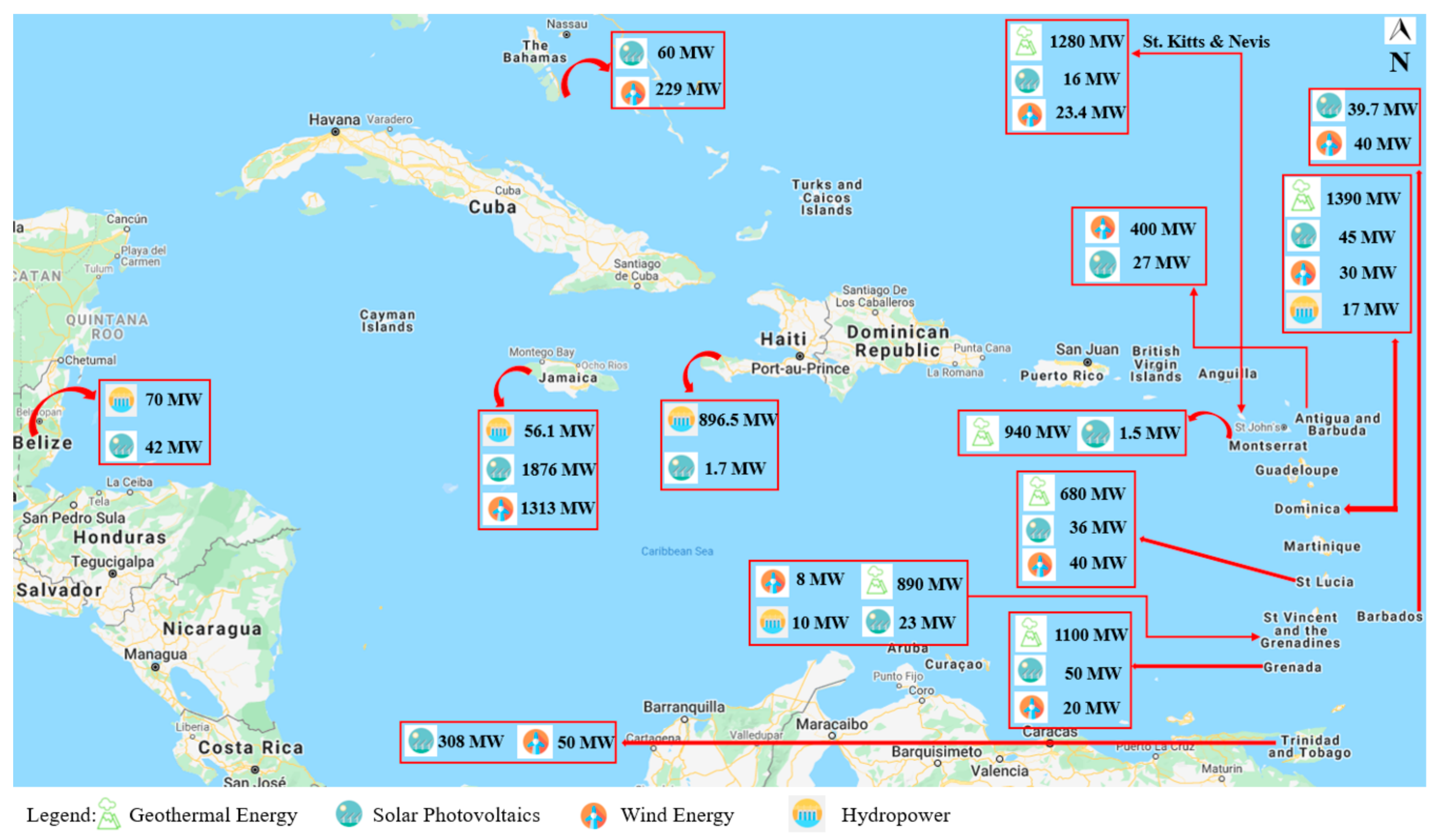
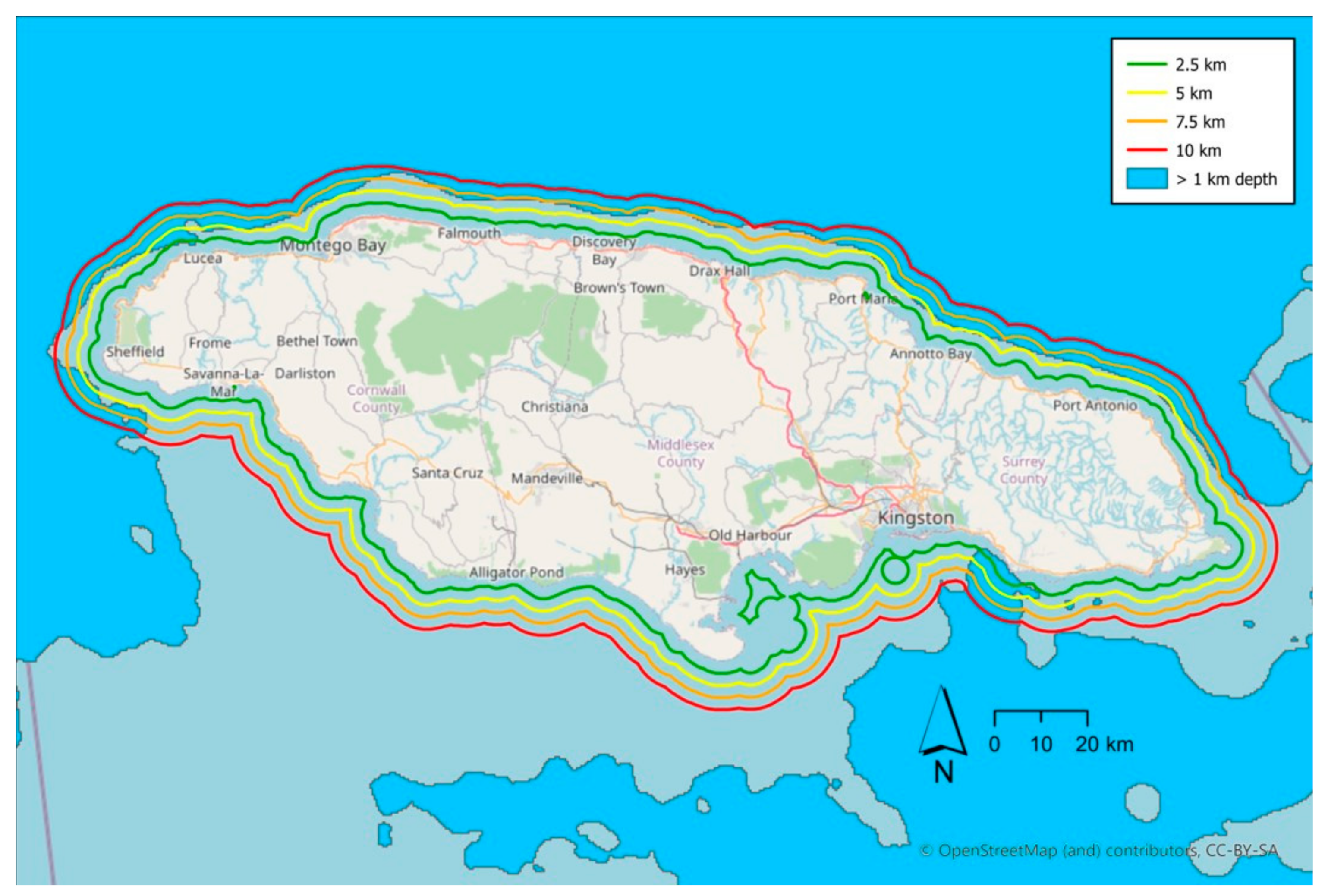
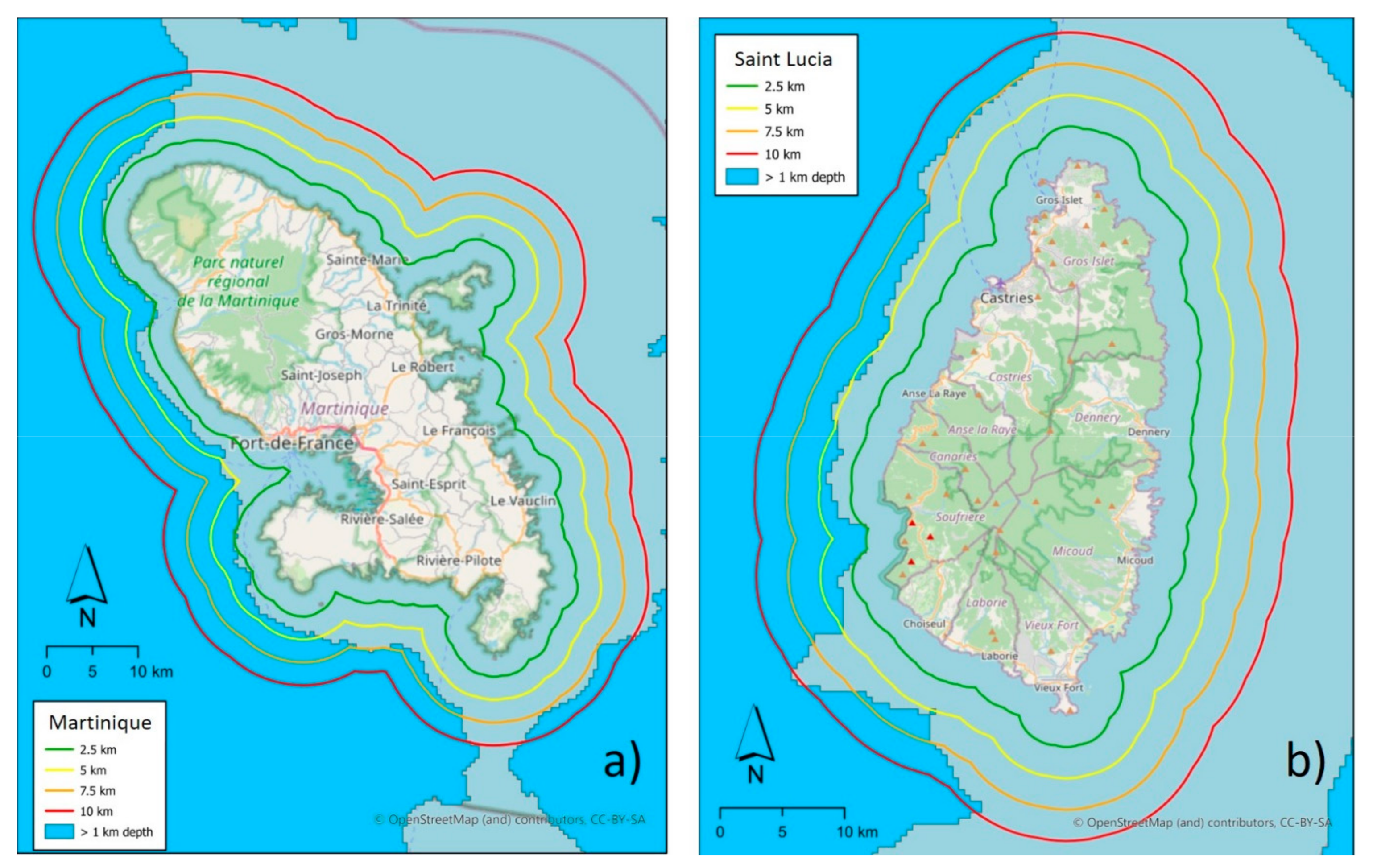
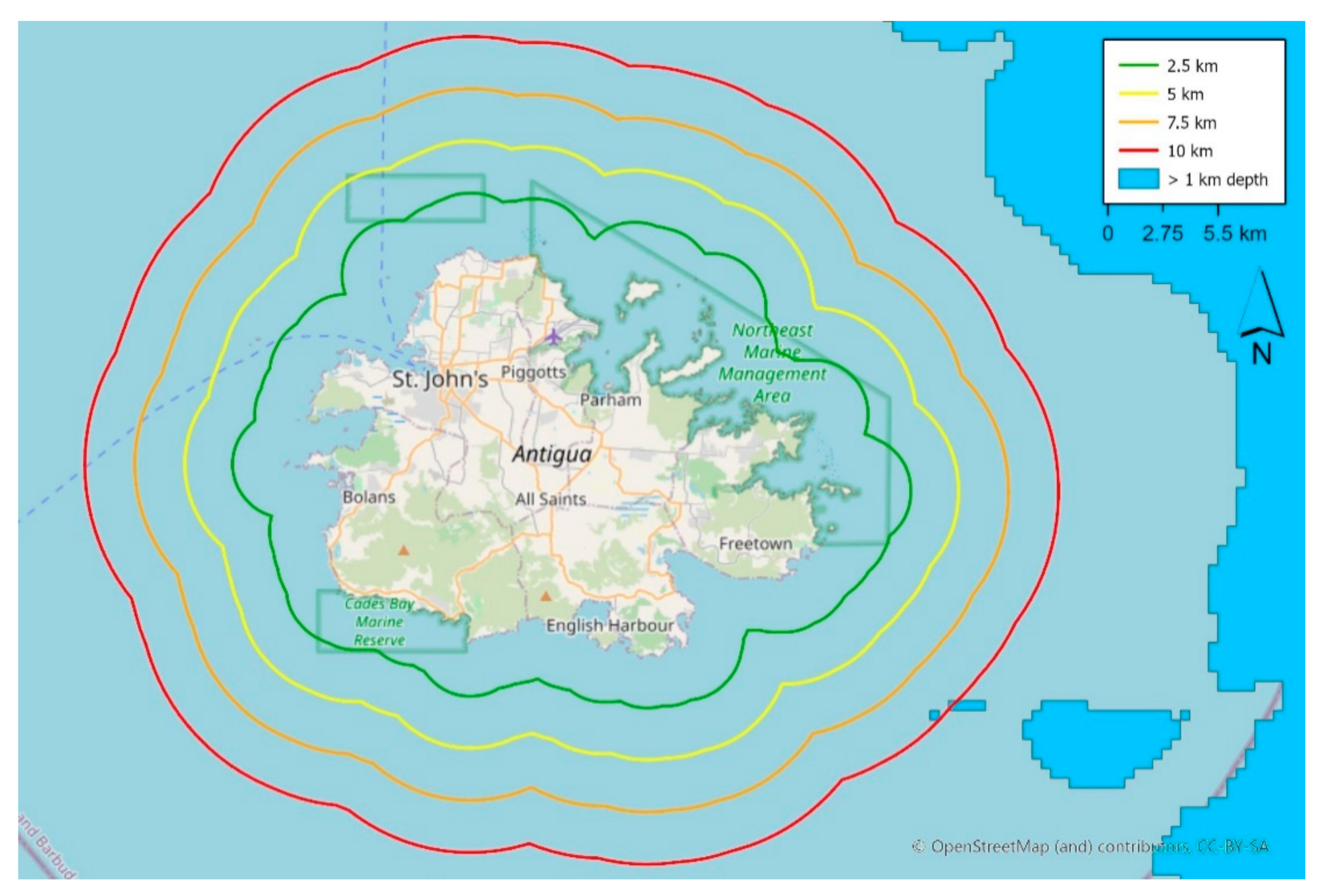
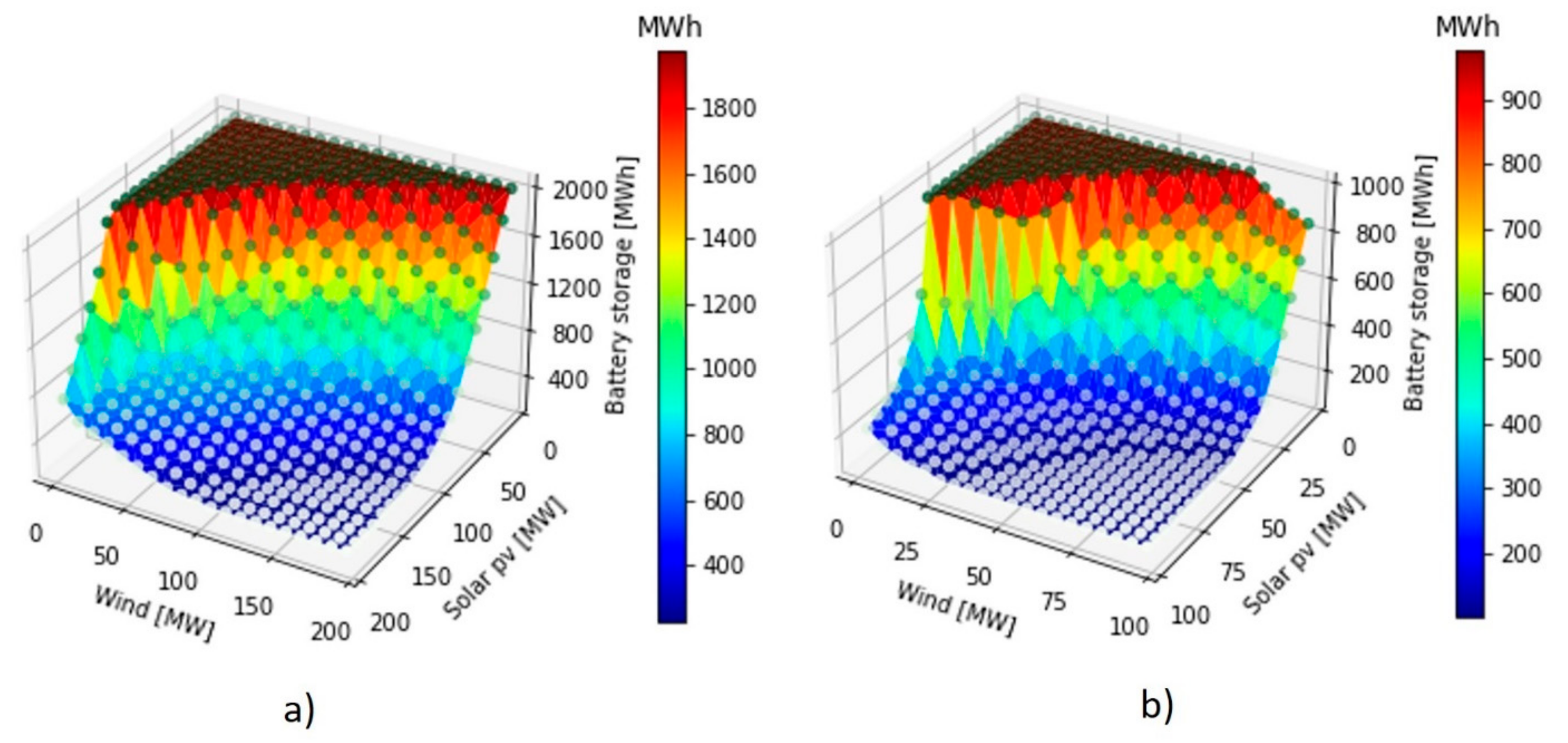
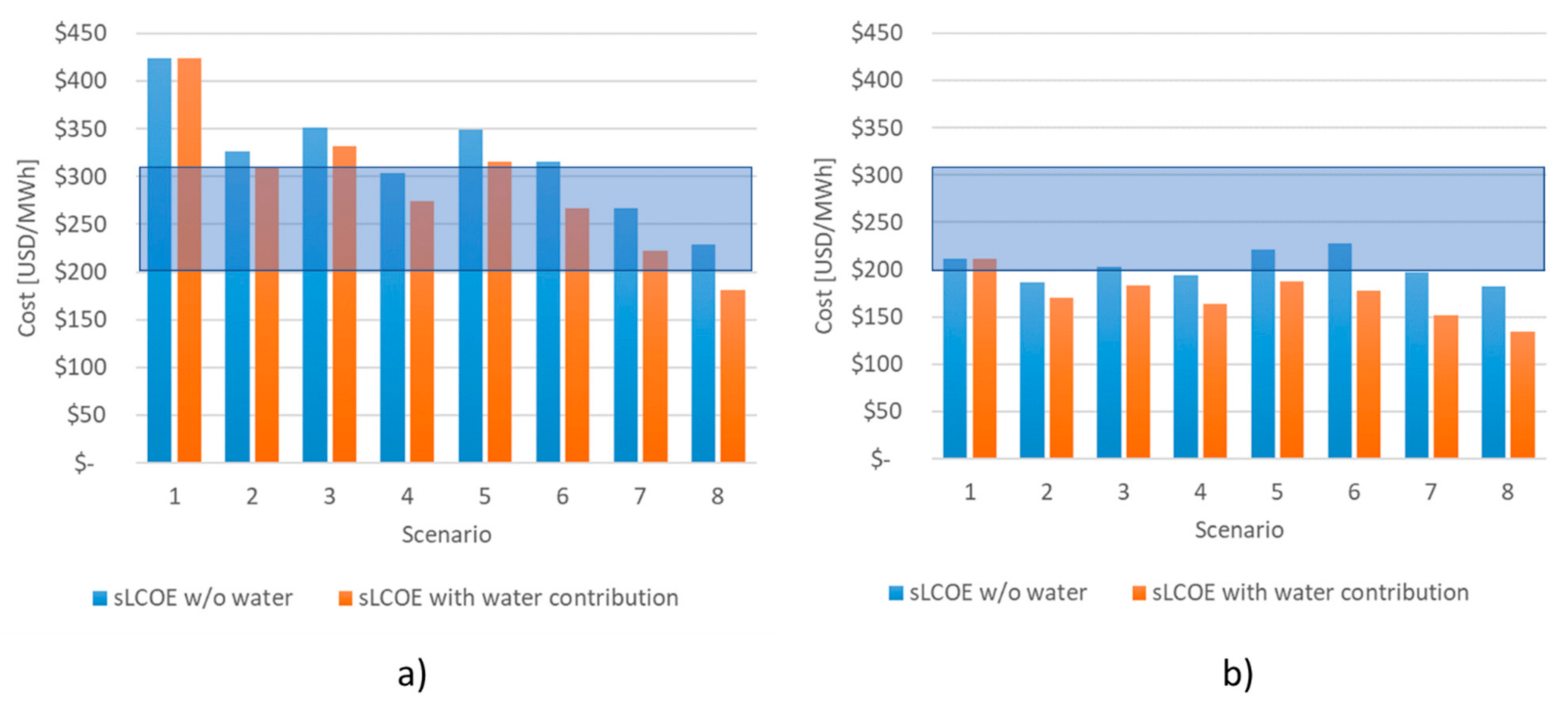
| Country | Hydropower | Geothermal | OTEC | Peak Demand (MW) | Residential Electricity Price (USD/kWh) |
|---|---|---|---|---|---|
| Bahamas | 308 | 0.32 | |||
| Cuba | |||||
| Turks and Caicos | 34.7 | 0.26 | |||
| Jamaica | 644 | 0.28 | |||
| Haiti | 500 | 0.13 | |||
| Dominican Republic | 2506 | 0.13 | |||
| Puerto Rico | 3685 | 0.22 | |||
| British Virgin Islands | 32 | 0.24 | |||
| U.S. Virgin Islands—St Thomas and St John | 88 | 0.40 | |||
| U.S. Virgin Islands—St Croix | 55 | 0.40 | |||
| Anguilla | 14 | 0.23 | |||
| Sint-Maarten/Saint-Martin | 42.6/32 | 0.30 | |||
| St Kitts and Nevis | 20.4 and 10.4 | 0.26 | |||
| Antigua and Barbuda | 50 | 0.40 | |||
| Montserrat | 2 | 0.50 | |||
| Guadeloupe | 254 | 0.19 | |||
| Dominica | 16.8 | 0.21 | |||
| Martinique | 235 | 0.11 | |||
| St Lucia | 60.3 | 0.28 | |||
| St Vincent and the Grenadines | 21 | 0.19 | |||
| Barbados | 168 | 0.25 | |||
| Grenada | 30 | 0.32 | |||
| Trinidad and Tobago | 1322 | 0.05 | |||
| Bonaire | 12 | 0.22 | |||
| Curaçao | 130 | 0.35 | |||
| Aruba | 135 | 0.17 |
| Peak power | 37.7 | MW |
| Yearly energy | 250 | GWh |
| Levelized cost of wind | USD 100 | /MWh |
| Levelized cost of solar PV | USD 100 | /MWh |
| Levelized cost of dispatchable renewable source (OTEC) | USD 300 | /MWh |
| Levelized cost of storage | USD 300 | /MWh |
| Lifetime of storage | 15 | years |
| Lifetime of system | 20 | years |
| Jamaica | Western | Negril (hotels, airport) |
| Northwestern | Lucea | |
| Northwestern | Montego Bay | |
| Southeast | East of Kingston | |
| Grand Cayman | All areas | George Town, Bodden Town, East End, West Bay |
| Cuba | Southeast | Santiago de Cuba |
| Northeast | Guardalavaca (tourist resorts) | |
| Northeast | Playa Uvero, Playa La Playita (tourist resorts) | |
| Northeast | Havana | |
| Bahamas | Central | Nassau |
| Turks and Caicos Islands | East | Cockburn Town |
| Haiti | West | Canal de St.-Marc, Canal de la Gonâve |
| Dominican Republic | South | Barahona, Paraíso, Los Patos |
| Puerto Rico | Southeast | Guayama |
| Guadeloupe | Northeast | Le Moule |
| Dominica | West coast | Roseau, Portsmouth |
| Martinique | West coast | Fort-de-France, St Pierre |
| St Lucia | Southwest | Soufriére |
| St Vincent and the Grenadines | West coast | Kingstown |
| Case | Solar (MW) | Solar (GWh) | Wind (MW) | Wind (GWh) | Disp. RE (OTEC) (MW) | Disp. RE (OTEC) (GWh) | Storage Capacity (MWh) | Energy from Storage (GWh) | Curtail. (%) | sLCOE (USD/MWh) | With Desal. Water (USD/MWh) |
|---|---|---|---|---|---|---|---|---|---|---|---|
| 1 | 200 | 335 | 73 | 204 | 0 | 0 | 2000 | 42.5 | 53 | 424 | 424 |
| 2 | 140 | 234 | 73 | 204 | 10 | 40 | 1000 | 17.8 | 48 | 326 | 300 (292, 309) |
| 3 | 120 | 201 | 53 | 150 | 10 | 46 | 1500 | 24.5 | 37 | 351 | 322 (313, 332) |
| 4 | 100 | 167 | 44 | 122 | 15 | 71 | 1000 | 15.8 | 30 | 304 | 259 (244, 274) |
| 5 | 90 | 151 | 34 | 95 | 15 | 79 | 1500 | 20.3 | 23 | 349 | 3299 (283, 316) |
| 6 | 80 | 134 | 17 | 48 | 20 | 117 | 1000 | 15.7 | 16 | 316 | 242 (218, 267) |
| 7 | 90 | 151 | 24 | 68 | 20 | 108 | 500 | 11.3 | 23 | 267 | 199 (177, 222) |
| 8 | 60 | 100 | 29 | 82 | 25 | 115 | 200 | 2.37 | 16 | 229 | 156 (133,181 |
Publisher’s Note: MDPI stays neutral with regard to jurisdictional claims in published maps and institutional affiliations. |
© 2021 by the authors. Licensee MDPI, Basel, Switzerland. This article is an open access article distributed under the terms and conditions of the Creative Commons Attribution (CC BY) license (https://creativecommons.org/licenses/by/4.0/).
Share and Cite
Brecha, R.J.; Schoenenberger, K.; Ashtine, M.; Koon Koon, R. Ocean Thermal Energy Conversion—Flexible Enabling Technology for Variable Renewable Energy Integration in the Caribbean. Energies 2021, 14, 2192. https://doi.org/10.3390/en14082192
Brecha RJ, Schoenenberger K, Ashtine M, Koon Koon R. Ocean Thermal Energy Conversion—Flexible Enabling Technology for Variable Renewable Energy Integration in the Caribbean. Energies. 2021; 14(8):2192. https://doi.org/10.3390/en14082192
Chicago/Turabian StyleBrecha, Robert J., Katherine Schoenenberger, Masaō Ashtine, and Randy Koon Koon. 2021. "Ocean Thermal Energy Conversion—Flexible Enabling Technology for Variable Renewable Energy Integration in the Caribbean" Energies 14, no. 8: 2192. https://doi.org/10.3390/en14082192
APA StyleBrecha, R. J., Schoenenberger, K., Ashtine, M., & Koon Koon, R. (2021). Ocean Thermal Energy Conversion—Flexible Enabling Technology for Variable Renewable Energy Integration in the Caribbean. Energies, 14(8), 2192. https://doi.org/10.3390/en14082192







